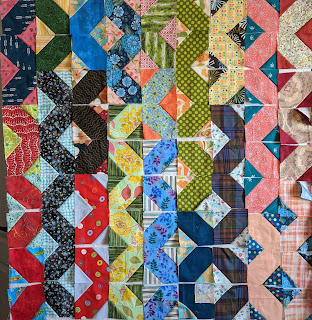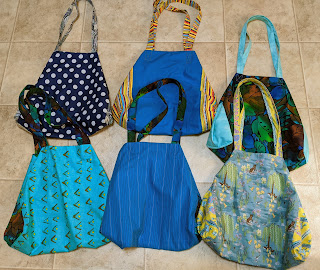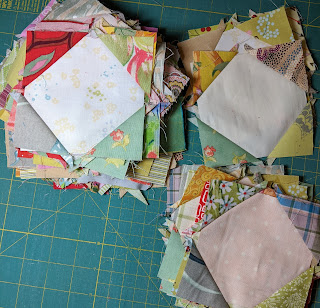Every test in our life makes us bitter or better, every problem comes to break us or make us. The choice is ours whether we become a victim or victor.
~Lorenzo Dozier
Quilting
Following my usual plan, I made so many of these blocks there's enough for a second quilt. This one had even more iterations because they blocks had been culled once for the previous Hatchet quilt. First the blocks were laid in the order they were sewn.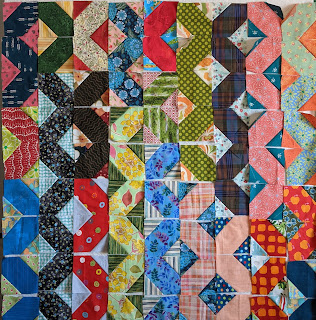 |
| Hatchet 2 baby quilt original blocks |
At first I regrouped some streamers and removed the light blue ones on the right.
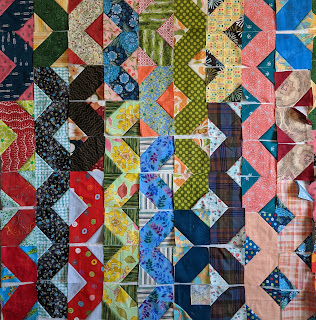 |
| Regrouping the Hatchet blocks |
Next I switched short blue and yellow streamers.
Then took out four beige blocks to add yellow and moved the light green to the right. I thought this was it but the digital camera revealed a less than attractive center line dividing left and right, dark and {mostly} light.
 |
| Still more adjustments to the Hatchet blocks |
Tweaking the coral and green streamers resolved that issue.
 |
| Hatchet 2 scrap quilt |
Having a few extra blocks made this possible. While not perfect I'm only using the scraps on hand, not going into the stash for more. Babies will like these graphic designs and I like clearing some space in my workroom.
Again the extra/discarded blocks make up part of the back. It always amazes me how well they work with each other and with the main backing choice.
 |
| Hatchet 2 scrap quilt back |
Parallel quilting lines, of course. The binding is a really bright carnival stripe.
Of course I saved the waste triangles. And sewed them up, too. I'm that crazy. They will wait in the HST box until needed for a border.
A week's work ended with another baby quilt as well as additions to the Parts Department. Now there are just narrow strings ready for my next project which should start next week.
There was even time to sew a few more pillowcases, too. These are more enjoyable than expected. They are useful, look pretty, and use fabric that had become stuck in my stash.
Monthly FUR (Fabric Use Rate)
Nineteen pillowcases, six totes, and two quilts used 41.25 yards for May. Tracking my usage is salutary or at least, educational. YTD = 103.75 yards.
Enjoy the day, Ann
 |
| Hatchet 2 scrap quilt detail |
Quilt Specifics
Size: 45" x 45"
Design: Hatchet or Signature block
Batting: Mountain Mist Cream Rose cotton
Thread: Superior 50 wt grey cotton thread
Quilting: Parallel lines with walking foot
Approximate yardage: 5.625 yds
Of course I saved the waste triangles. And sewed them up, too. I'm that crazy. They will wait in the HST box until needed for a border.
 |
| Waste triangles sewn into small HSTs |
The next troll through the scrap bag pulled strips 2.5" or more to cut into squares for a future Trip Around the World quilt.
 |
| Squares for a Trip Around the World |
A week's work ended with another baby quilt as well as additions to the Parts Department. Now there are just narrow strings ready for my next project which should start next week.
There was even time to sew a few more pillowcases, too. These are more enjoyable than expected. They are useful, look pretty, and use fabric that had become stuck in my stash.
Reading
Just in time for an online discussion, I found the History book club through MFAH which meets quarterly. Usually they gather at Bayou Bend or Reinzi but with the stay -at-home order they set up online, at least this time. And guess what? The book was Bill Bryson's At Home! So of course, I joined in. There's a list of previous discussion books here.Monthly FUR (Fabric Use Rate)
Nineteen pillowcases, six totes, and two quilts used 41.25 yards for May. Tracking my usage is salutary or at least, educational. YTD = 103.75 yards.
Enjoy the day, Ann
